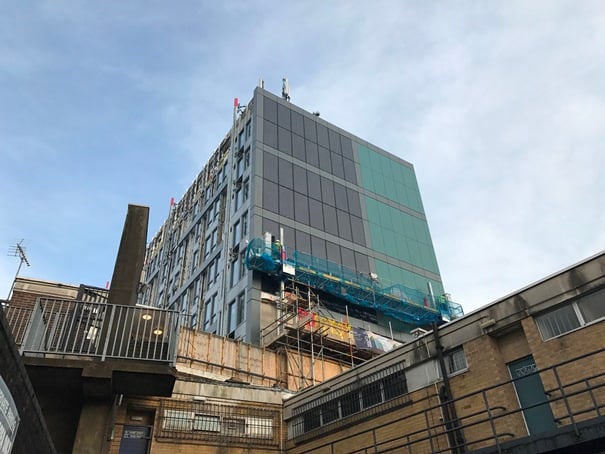Research indicates the market for curtain walling is growing at a healthy rate of around 6% per annum. (A curtain wall is the non-structural weather proof covering of a building, generally associated with large multi-storey buildings.) This rise is driven both by new build construction and by energy efficient refurbishments of existing buildings.
Standard curtain walling improves the thermal insulation of the building, leading to reduced HVAC costs and reduced heat loss. It also improves the aesthetic appearance of the building.
A photovoltaic curtain wall has the added benefit of generating electricity over the building’s life.
Whilst it costs a bit more than standard curtain walling, the incremental cost of a BIPV facade will typically be paid back within around five years.
Materials
The standard material for a photovoltaic facade is thin film glass (see picture below). Poly- / mono- crystalline solar glass or panels can also be used (for example we installed these as part of the refurbishment of Oxford Council’s Hockmore Tower, pictured above).

Polysolar PS-A opaque series panels (4.6 kWp), Future Business Centre, Cambridge.
Thin film solar is less efficient than crystalline solar, but thin film tends to be favoured for solar windows and photovoltaic facades for a number of reasons:
- Better low light performance. Thin film performs better in lower light, and is recommended for applications with a significant proportion of diffuse light (produced by reflection and light scattering), and in cloudy or dull weather climates.
- Better performance in shaded environments, for two reasons:
- Thin film absorbs a wider spectral range than crystalline. The sun’s spectrum ranges from short wavelength UV light to long wavelength infrared light. In contrast to crystalline cells, which absorb primarily long wavelength radiation (red light spectrum), thin film solar cells can absorb a wide spectral range, in particular thin film can absorb the short wavelength blue light on cloudier days or when the sun is low in the sky.
- Thin film modules are designed to be high voltage and so are linked in parallel rather than in series in long strings. This means that if one module is shaded the rest of the system is not affected. Each module is therefore optimised. This effect can be replicated on crystalline modules with the use of a product such as SolarEdge, with one power optimiser per module, however this typically adds 10-15% to project costs.
- Better ‘extreme’ angle performance. Thin film performs well at the more extreme angles to the sun and thus works well for vertical surfaces and northerly aspects, allowing north facing facades of buildings to be included in the BIPV project.
- Thin film performs better with temperature build-up, even where no ventilation is possible. The standard ‘rating’ of panels is made at 25°C. In reality, even in the UK, the module surface temperature can reach 55°C – 70°C in summer, reducing yield by 15% + for silicon cell, compared to 5% + for thin film. Put another way, with silicon cells, performance drops off at a rate of 0.5% per Kelvin; the equivalent thin film drop-off rate is around 0.17% per Kelvin.
Transparency and colour
Thin film transparency varies from 0% (so 100% opaque / non see-through) to 50%. Photovoltaic glass can be mixed with standard glass to increase light transmission. For example, photovoltaic glass could be used as spandrel glass, used to hide a construction material or structure (e.g. between floors).
Finally, thin film photovoltaic facades come in a range of colours, offering the potential for aesthetic innovation.
Mounting
Photovoltaic glass can be mounted using most standard curtain walling and bonded glazing systems, from suppliers such as Nvelope, Technal, Kawneer, Comar, SAPA, Reynaers, SAS, and Schüco.
The standard aluminium profiles require only slight adaptation to accommodate the wiring and connectors required for solar glazing.
Cost
The cost of photovoltaic glass is similar to, and sometimes less than, the cost of other curtain walling materials. The main ‘incremental’ cost is that of the electrical wiring – running dc cables between panels, installing inverters, and running ac cable to the main building distribution board (or to a sub-board).
Our analysis shows that this cost is typically re-paid by electricity bill savings within five years:
|
Product |
W/m2 |
Cost / of electrical components and electrical installation (1) |
Approx annual output from an unshaded vertically mounted panel facing south / m2 (2) |
Annual Electrical Savings per m2 [@ 13p per kWh] (3) |
‘Payback’ time for additional installation cost (electrical components /install only) |
|
Opaque thin film |
120 |
£42/m2 |
65 kWh |
£8.50 |
~ 5 years |
|
30% Transparent thin film |
56 |
£20/m2 |
30 kWh |
£4.00 |
~ 5 years |
|
Opaque silicon |
70 |
£25/m2 |
38 kWh |
£5.00 |
~ 5 years |
|
20% Transparent silicon |
63 |
£22/m2 |
34 kWh |
£4.50 |
~ 5 years |
Notes:
(1) This is assumed to be the ‘uplift’ cost of installing photovoltaic glazing versus normal glazing. Assumes the photovoltaic glazing is similarly priced to normal glazing.
(2) Reduce by 28% if east / west facing and by 62% if north facing. Reduce further if panels are likely to be shaded.
(3) Assumes all electricity is used on site.
Conclusion
If you are interested in finding out more, or in getting a quote for a project, please get in touch.
It's quickest to email commercial@spiritenergy.co.uk or to call our estimating department on 0118 951 4490. Alternatively click here and complete our online form:










